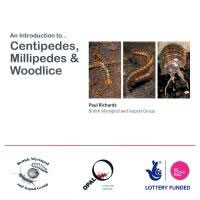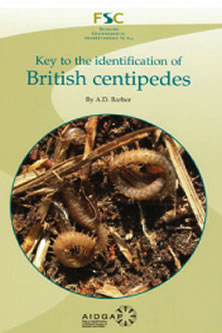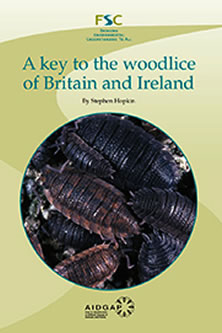The most recent identification guides to British and Irish species (some may need to be purchased) are listed below.
Other identification guides are freely downloadable. Also see Resources > Online Resources > woodlice & waterlice and millipedes & centipedes tabs.
An Introduction to Centipedes, Millipedes and Woodlice
by Paul  Richards (2011). Now free to download (see below).
Richards (2011). Now free to download (see below).
Although good taxonomic guides exist for these animals, there is a gap between beginners’ introductions to invertebrates and specialist literature for identification. BMIG wanted to bridge this gap and popularise these animals in a modern and accessible way.
The three guides that are presented here have been written to raise the profile of Centipedes, Millipedes and Woodlice, teach a little biology and equip the reader to do the same. They are intended as a resource to propagate study of the important, but little noticed, animals. They offer introductory keys, natural histories and a rich library of images for individual or group study.
The four files (previously only available on CD ROM) are now available to view or download for free in pdf format. There is an Introduction section, and three files: 1) Myriapods and Centipedes, 2) Millipedes and 3) Woodlice.
Centipede Identification
There are two modern identification guides for our species; both by A.D. (Tony) Barber and both are obtainable from FSC Publications.
Key to the identification of British centipedes ~ AIDGAP key (2008)
This is primarily aimed at those lacking experience in centipede identification.
Centipedes ~ Linnean Society Synopsis (New Series) 58 (2009)
This uses the same identification key, but provides a more detailed account of each species including additional figures and is suitable for more experienced users.
Centipedes of the British Isles
Ted (E.H.) Eason's (1964) classic but standard work, from which the above derive much of their information, has been long out of print. It is now available on CD in Adobe Acrobat pdf format, with fully searchable text and hyperlinks for ease of navigation. Although some of the nomenclature has since changed, the original species descriptions, illustrations and details of distribution remain invaluable.
Key to the Centipedes of Northern France
A fully illustrated key (by Iorio, Labroche & Jacquemin, 2022) to the identification of the 74 species of centipede known to occur in Northern France can be downloaded free online. It includes most (if not all) of the centipedes known to occur in Britain and Ireland and several that could eventually make it across The Channel. The text is in French but the illustrated identification key is duplicated in English.
Millipede Identification
The only available key to millipedes is the 1985 Synopsis of the British Fauna No. 35 by J. Gordon Blower published by The Linnean Society and Brill/Backhuys. Sadly it is out of print, but it may be possible to obtain copies through specialist entomological book sellers or online sellers of second hand books.
A revised key is being prepared by Paul Lee and Helen Read, and draft versions may be made available to active recorders.
Woodlouse Identification
Woodlice of Britain and Ireland
There are two main publications for the identification of woodlice of Britain and Ireland:
A key to the woodlice of Britain and Ireland ~ FSC AIDGAP key (1991)
The Field Studies Council AIDGAP key by Steve Hopkin is widely regarded as better for living woodlice or fresh material. It contains keys to 35 species of woodlice known (in the 1990s) to be native or naturalised in the British Isles. Colour plates support detailed line drawings and confirmatory descriptions of each species include notes on distribution and natural history.
Woodlice ~ Linnean Society Synopsis (New Series) 49 (1993)
The Linnean Society Synopsis by Oliver & Meechan provides a detailed account of all 38 species which were known up to date of publication. It is suitable for more experienced users and particularly helpful for preserved specimens. Unfortunately it seems to be no longer available from the FSC website (out of print?).
Illustrated key to Woodlice of Berks, Bucks and Oxon
This guide (by Steve Gregory, 2019) only includes species of woodlouse known to occur in central southern England, so exclusively coastal species and those only found further north are not included. Downloadable as pdf ~ here
Key to the woodlice of Northern France
A fully illustrated key (by Noël & Séchet, 2021) to the identification of the 69 species of woodlice known in Northern France can be downloaded free online. It includes all native and naturalised woodlice known to occur in Britain and Ireland, except Metatrichonicoides celticus, and several woodlice that could eventually make it across The Channel. The text is in French but the 93 colour figures help make it accessible to all.
Waterlouse (Water Slater) Identification
A key to the four species of water-slater in Britain and Ireland is included in:
Gledhill, A.T., Sutcliffe, D.W. & Williams, W.D. (1993). British freshwater Crustacea Malacostraca: a key with ecological notes. Freshwater Biological Association Scientific Publication No 52. Available from FBA website.
Symphyla Identification
Unfortunately there is no up-to-date identification guide to British and Irish Symphyla.
- An introduction to the group and the pit-falls of identification are highlighted in: Hopkin, S.P. & Roberts, A.W. (1988). Symphyla – the least studied of the most interesting soil animals. Bulletin of the British Myriapod Group 5: 28-34.
- The standard identification work to our known species remains: Edwards, C.A. (1959). A revision of the British Symphyla. Proceedings of the Zoological Society of London, 132: 403-439.
- A key to the species of Sweden is given in: Andersson, G., Meidell, B.A., Scheller, U., Winqvist, J.-Å., Osterkamp Madsen, M., Djursvoll, P., Budd, G. & Gärdenfors, U. (2005). Nationalnyckeln till Sveriges flora och fauna. Mångfotingar. Myriapoda. (CF). Uppsala: ArtDatabanken, SLU. This is relatively expensive to purchase and the text in Swedish.
Links to other publications that include species in addition than our known ones include:
- Phylogeny of the Symphyla (Myriapoda) with a key to the European genera of Symphyla (page 45) - here
- An identification key to the Symphyla of Romania - here
- The Pauropoda and Symphyla of the Geneva Museum V ~ A review of the Swiss Scolopendrellidae (Myriapoda, Symphyla) - here
- New distributional data on the Symphyla (Myriapoda) in Spain (with comments on some Scolopendrellopsis, Symphylella) - here
- A key to 43 species of the genus Symphylella (we have 3 known species) - here
Pauropod Identification
In prep.
